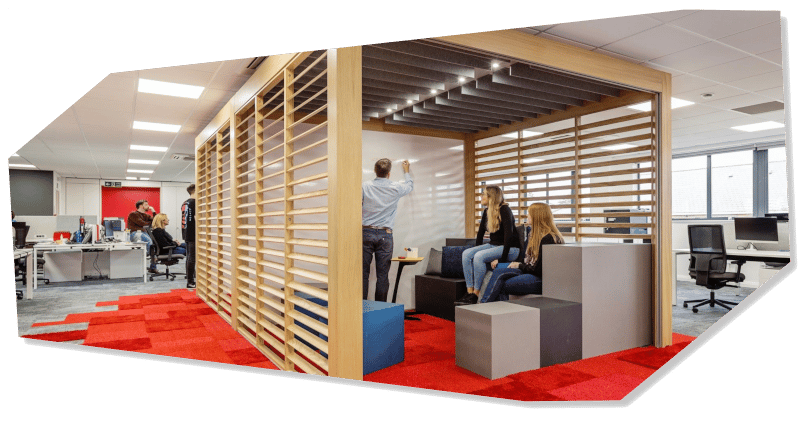The concept of the ‘future-ready’ workspace is one that’s been around for some time now, and in fairness it can often seem like a slightly vague idea. After all, how can we prepare for an uncertain future without concrete details to work with? Aren’t we better off looking to solve the workplace problems of the here and now?
The events of the pandemic, however, have shown just how important it is to be able to flex and adapt to an unpredictable future. Businesses of all kinds have had to learn quickly how to move to new ways of working, embracing hybrid models and virtual workspaces, while realigning their physical workspaces to better support these new working patterns. Some businesses were already one step ahead, while others had to run to catch up. But if the events of the last two years have taught us anything, it’s that there’s no excuse for not being ready for the unexpected from now on.
We need to plan for an unpredictable future
The future-ready workspace is about building in the flexibility and adaptability needed to face an unpredictable, sometimes dramatically changing world head on. But more than that, it’s about building the workspace around people, offering choices in how and where work gets done, in order to provide the best possible environments for different roles and activities, and for different working personas.
People are remarkably adaptable and resilient. We can usually find the best way through in any given situation, no matter how out of the ordinary. Our workspaces need to catch up with that ability, so that they enable, rather than hinder, our natural human adaptability.
The evolution of work
The tide of workplace change didn’t start with the pandemic. Recent events have only served to accelerate a trend that had already been in motion for some time, driven by longer term changes in the nature of work. These changes are largely the result of advances in technology, and its impact on the type of work carried out by knowledge workers, as well as a revolution in where, how and when that work gets done.
The role of automation
Advances in AI and workplace technology mean that many basic and repetitive procedural tasks that used to require hands-on human effort have now been replaced with more time- and cost-effective automation systems. With less of a focus on admin work, people are freed up to concentrate on higher level tasks including decision-making, problem-solving, creative thinking and collaboration.
This has meant a change in focus for knowledge workers across a broad range of industries. The shift towards higher level knowledge work, collaborative decision-making and problem-solving means that workers come together in new ways that are often location-independent, to discuss and plan. It also means that individual concentrated work is back in the spotlight – it isn’t all about brainstorming and meetings.
The advance of cloud-based technologies
Another key trend in the evolution of work is the rise of location-independent working, fundamentally changing where and how work takes place. Advances in cloud-based communication, collaboration and data hosting have given rise to a more fluid, dynamic workforce that benefits from a range of work settings, both within and beyond the physical office – enabling us to work where and how best suits the task in hand, as well as catering to our individual work preferences.
The rise of the cognitive worker
For many roles, the definition of productivity has changed – moving away from maximising the output of simple procedural tasks, towards optimising decision-making and mental performance. This shift from a purely quantitative to a more qualitative measure of output has implications for the workspace, both physical and virtual, and how it best enables and supports the work we do. Fixed teams and unchanging patterns of work no longer work for us, and the workspaces of tomorrow need to reflect this move towards agile, adaptable work settings and environments, that reflect this more fluid, dynamic way of working.
In the new paradigm, workspaces need to look, feel and function differently in order to help us to do our best work.
Workspace fundamentals – A blueprint for people performance
Productive workspaces are built around people and their needs. Some of these needs vary between different roles and individuals, whereas others are more universal.
Universal attributes are ones that every workspace needs to provide an optimal environment for people to perform at their best. Intelligent workspace design must consider each of these factors individually and in combination in order to provide an optimised workspace that drives people performance:
- Productivity
The workspace must be designed with productivity at its heart. What this looks like in practice will be different depending on the organisational profile. Workplace consultancy provides a framework within which to identify the types of work carried out, individual and group dependencies, working patterns and processes. This feeds into considerations in layout, design, and function within the workspace.
- Agility
Agile workspaces enable people to move seamlessly between different work settings and roles, choosing the optimal environment for the task at hand. Organisations need to consider how their employees will transition smoothly between different tasks and zones, how they will connect both on- and off-site. Connectivity and flexibility are key to supporting an agile work style, allowing people to take their work with them from one space to another, with access to plug and play technology and cloud-based data storage, as well as multi-functional, adaptable spaces.
- Collaboration
Collaboration is key for creative, problem-solving work. The ability to connect with teams, both in the physical and virtual space, for enhanced collaboration, is essential to drive productivity. This means a workspace that fosters teamwork in the physical space, while also bringing people together in the virtual space, so that dispersed teams can work together as easily as if sharing a room. Working beyond single locations will become increasingly important in scaling business operations and drawing talent from a wider geographical pool.
- Belonging
The physical workspace acts as a hub for a company’s values, culture, ethos and community. The rise of the destination office reflects this shift away from the workplace as purely functional space that people are required to attend, towards a more aspirational space that people choose to attend in order to reconnect with their colleagues, forge a sense of shared purpose and belonging that boosts engagement and commitment to the business. In an increasingly competitive talent market, organisations need to work harder than ever to give people reasons to stay, beyond just pay packet and perks, and a sense of shared values is central to this.
- Autonomy
Now more than ever, people value the freedom to choose the right locations, work settings and tools for the work they undertake. Since the events of the pandemic, location-independent working and the array of tools and technologies that support this have come to be expected by workers, who have discovered productivity gains and a better work-life balance by ditching the daily commute. Enabling hybrid working for the roles that it is suitable for shows trust and confidence in people that is rewarded by more motivated, empowered staff who are more likely to go the extra mile.
- Wellbeing
The pandemic provided an opportunity for many people to reevaluate their relationship with work, considering issues such as wellbeing, work-life balance and the way they allocate their time to different commitments. Many people found working from home improved their productivity, while dropping the daily commute provided hours of additional time. In the war for talent, being able to offer hybrid working is now on many candidates’ wish lists. Furthermore, office environments are beginning to reflect more of the comforts of the home environment, from enhanced amenities and recreational facilities to a wider range of non-desk work settings, breakout spaces and zones.
In our next blog, we’ll be taking a closer look at how you can shape your workspace around the specific needs of your business and your people – beginning with how to better understand your workforce’s needs.
How Office Workspace can help
We can help you to take the first steps on your journey to a more productive, effective and engaging workplace. It’s as simple as having an informal chat with one of our workspace team, to find out a bit more about your business and your drivers for change.
To find out more about how we can help you to innovate the way you work, get in touch by emailing hello@officeworkspace.com or calling +44 (0)20 8039 0000. You can also fill out our online contact form, and we’ll get back to you as soon as possible.

